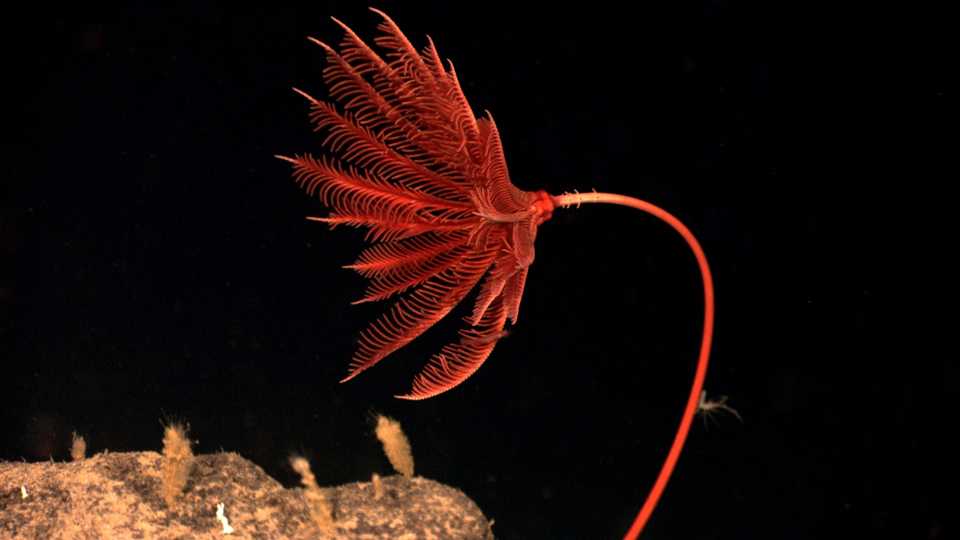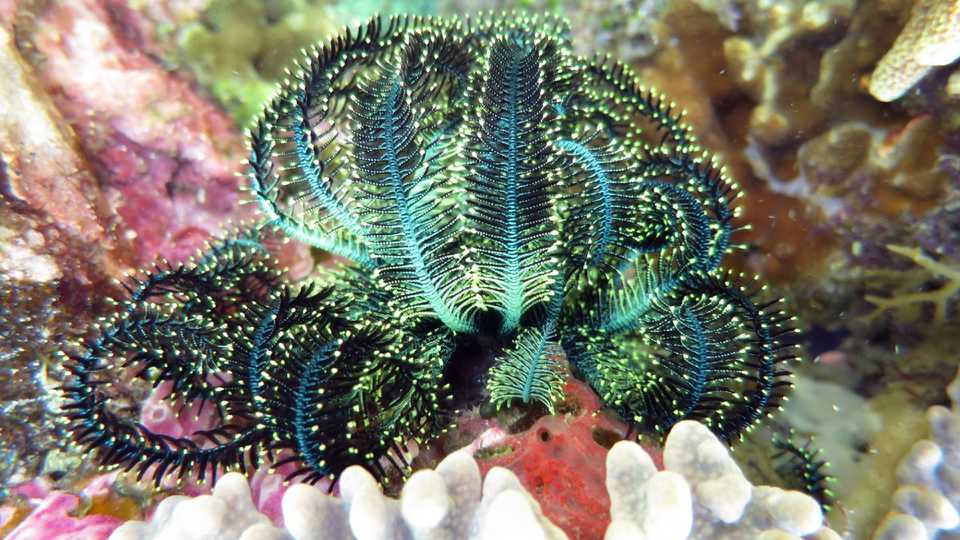New fossil animal named after the goddess Athena shows how sea lilies’ arms evolved
SAN FRANCISCO (December 9, 2019) - Sea lilies, despite their name, aren’t plants. They’re animals related to starfish and sea urchins, with long feathery arms resting atop a stalk that keeps them anchored to the ocean floor. Sea lilies have been around for at least 480 million years—they first evolved hundreds of millions of years before dinosaurs roamed the Earth. For nearly two centuries, scientists have thought about how modern sea lilies evolved from their ancient ancestors. In a new study in the Journal of Paleontology, researchers from the California Academy of Sciences, the Field Museum, and beyond are rewriting the sea lily family tree, aided by newly-discovered fossils that help show how these animals’ arms evolved.
“No one has looked at the evolution of the very earliest sea lily fossils in quite this way before,” says Rich Mooi, a collaborator on the paper, and an invertebrate zoology curator at the California Academy of Sciences. “Such a new approach, sparked by newly discovered fossils, was bound to break with some old ideas, and we were definitely not disappointed in that regard.”
Sea lilies are more formally known as crinoids, but they’ve earned their nickname—they look remarkably like flowers growing at the bottom of the ocean. They spend their adult lives stuck in mostly one place, with stem-like stalks that attach them to the sea floor. At the top of these stalks are a cluster of arms, about the size of the palm of your hand. These arms trap tiny plankton floating through the water, which the sea lily then eats.
“Some people actually consider sea lilies and their relatives, the feather stars, the most beautiful animals. They come in any color—purple, bright red, green,” says Tom Guensburg, the paper’s lead author and a research associate at the Field Museum in Chicago. “They look plant-like, but when you actually look at their bodies, you find all the usual anatomy of complex animals like a digestive tract and nervous system—they’re closer to vertebrates, and us, than almost any other invertebrate animals.”
In the new paper, Guensburg and his colleagues describe a new kind of fossil sea lily they named Athenacrinus broweri, after the Greek goddess Athena. “Athena is often depicted with rangy, almost gangly limbs on ancient Greek vases; this fossil’s arms are long and thin too,” explains Guensburg. “Athena is the goddess of wisdom, and this fossil tells us something important about the origin of this group. This fossil has great significance.”
The discovery has been a long time coming. In 1846, scientists were steadily building the family tree of the echinoderms—animals like sea lilies, starfish, sand dollars, sea urchins, sea cucumbers, and a host of extinct groups. In the fossil record, they found ancient animals that look like modern sea lilies, with stalks ending in a bunch of delicate arms called cystoids. They figured that both of these ancient animals must be closely related. But beginning in the 1950s, some scientists expressed doubts that cystoids belonged with the sea lilies—that similarities were superficial only. Still, evidence used to argue that crinoids and cystoids were only distantly related has been criticized to this day by those favoring the traditional idea of crinoid origin.
Arm structure of Athenacrinus turned out to be key to figuring out how sea lilies evolved from earliest-known echinoderms, some of these up to 515 million years old. The earliest echinoderms didn’t yet have arms, but they did have plates in their bodies similar to those found in earliest crinoid arms. It appears the plates in the earliest crinoid arms preceded the origin of arms themselves. These plates are nowhere to be found in sea lilies beginning 450 million years ago. And while modern sea lilies have different arm plating, they have tissues that are remnants inherited from this ancient pattern. The new paper in the Journal of Paleontology shows that early sea lilies from 480 million years ago are the missing link between the earliest sea lily ancestors and what we see in living crinoids.
Cystoids, meanwhile, have different arm structures Guensburg says indicate that cystoids don’t actually belong to the same class of animals as sea lilies. “These new fossils provide for the first time an accurate picture of what the earliest crinoid arms were like, and they are unlike any cystoid in important ways,” says Guensburg; “No cystoid has such anatomy.” That means, according to the researchers, that crinoids and cystoids are related only at the most ancient levels in echinoderm history, but that they aren’t most closely related to each other. “One of the most fascinating branches of the tree of life, echinoderms, needs rearranging,” he notes. “That’s a big deal.”
The researchers say that piecing together how sea lilies evolved helps broadens our understanding of all life. “What makes humans different from other animals is that we’re curious about understanding our place in the universe and understanding our place in the history of life,” says Guensburg. “This is a piece of that—it’s what makes life interesting.”
The Institute for Biodiversity Science and Sustainability at the California Academy of Sciences is at the forefront of efforts to understand two of the most important topics of our time: the nature and sustainability of life on Earth. Based in San Francisco, the Institute is home to more than 100 world-class scientists, state-of-the-art facilities, and nearly 46 million scientific specimens from around the world. The Institute also leverages the expertise and efforts of more than 100 international Associates and 450 distinguished Fellows. Through expeditions around the globe, investigations in the lab, and analysis of vast biological datasets, the Institute’s scientists work to understand the evolution and interconnectedness of organisms and ecosystems, the threats they face around the world, and the most effective strategies for sustaining them into the future. Through innovative partnerships and public engagement initiatives, they also guide critical sustainability and conservation decisions worldwide, inspire and mentor the next generation of scientists, and foster responsible stewardship of our planet.
This study was contributed to by Tom Guensburg of the Field Museum, and his co-authors James Sprinkle of the Jackson School of Geosciences at the University of Texas, Rich Mooi of the California Academy of Sciences, Bertrand Lefebvre of France’s Université Claud Bernard, Bruno David of France’s Université de Bourgogne Franch-Compté, and Muséum National d’Histoire Naturelle, Paris, Michel Roux, also of the Muséum National d’Histoire Naturelle, and Kraig Derstler of the University of New Orleans.
Press Contacts
If you are a journalist and would like to receive Academy press releases please contact press@calacademy.org.
Digital Assets
Hi-res and low-res image downloads are available for editorial use. Contact us at press@calacademy.org to request access.

